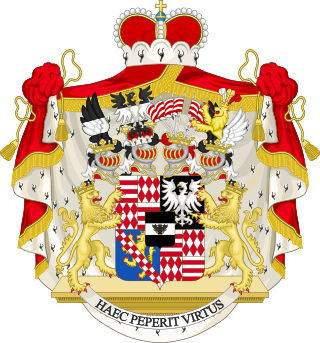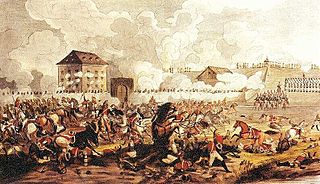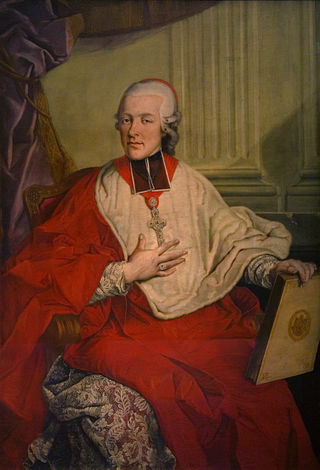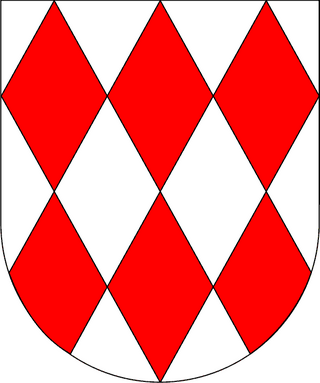See also
- Colloredo di Monte Albano, comune (municipality) in the Province of Udine in the Italian region Friuli-Venezia Giulia
- Villa Colloredo Mels - Civic Museum in Recanati, Marche
Colloredo is a surname that may refer to:
Hieronymus, in English pronounced or, is the Latin form of the Ancient Greek name Ἱερώνυμος (Hierṓnymos), meaning "with a sacred name". It corresponds to the English given name Jerome.

The House of Colloredo-Mansfeld is an originally Italian noble family of which a branch came to Austria in the late 16th century. There they were raised to barons in 1588, imperial counts in 1727 and imperial princes in 1763. They obtained Opočno Castle in the Kingdom of Bohemia in 1634 and acquired numerous further estates in Bohemia and Austria. In 1945 they were expropriated and expelled from the Czechoslovak Republic, but returned after 1990 and had parts of their former estates restituted.
Mansfeld is a town in Saxony-Anhalt, Germany.

The Battle of Raab or Battle of Győr was fought on 14 June 1809 during the Napoleonic Wars, between Franco-Italian forces and Habsburg forces. The battle was fought near Győr (Raab), Kingdom of Hungary, and ended in a Franco-Italian victory. The victory prevented Archduke John of Austria from bringing any significant force to the Battle of Wagram, while Prince Eugène de Beauharnais's force was able to link up with Emperor Napoleon at Vienna in time to fight at Wagram. Napoleon referred to the battle as "a granddaughter of Marengo and Friedland", as it fell on the anniversary of those two battles.
Ebner is a Germanic surname. Notable people with the surname include:

The Battle of Piave River was fought on 8 May 1809 between the Franco-Italian army under the command of Eugène de Beauharnais and an Austrian army led by Archduke John of Austria. The Austrian commander made a stand behind the Piave River but he suffered a defeat at the hands of his numerically superior foes. The combat took place near Nervesa della Battaglia, Italy during the War of the Fifth Coalition, part of the Napoleonic Wars.

Hieronymus Karl Graf von Colloredo-Mansfeld was an Austrian corps commander during the Napoleonic Wars.

The Electorate of Salzburg, occasionally known as the Grand Duchy of Salzburg, was an electoral principality of the Holy Roman Empire from 1803–05, the short-lived successor state of the Prince-Archbishopric of Salzburg.

The Residenzgalerie is an art gallery in the Alte Residenz, Salzburg, Austria. Its collection includes works by Rembrandt, Carel Fabritius, Carlo Saraceni and Hieronymus Francken II.

Hieronymus Joseph Franz de Paula Graf Colloredo von Wallsee und Melz was Prince-Bishop of Gurk from 1761 to 1772 and Prince-Archbishop of Salzburg from 1772 until 1803, when the prince-archbishopric was secularized. After secularization, Colloredo fled to Vienna and remained the non-resident archbishop of Salzburg, bereft of temporal power, until his death in 1812. He is most famously known as a patron and employer for Mozart.

Heinrich XV, Prince Reuss of Greiz was the fourth of six sons born into the reigning family of the Principality of Reuss. At the age of fifteen he joined the army of the Habsburg monarchy and later fought against Ottoman Turkey. During the French Revolutionary Wars he became a general officer and saw extensive service. He commanded a corps during the Napoleonic Wars. From 1801 until his death, he was Proprietor (Inhaber) of an Austrian infantry regiment.

The House of Mansfeld was a princely German house, which took its name from the town of Mansfeld in the present-day state of Saxony-Anhalt. Mansfelds were archbishops, generals, supporters as well as opponents of Martin Luther, and Habsburg administrators.
Münchhausen is the surname associated with a German noble family of Münchhausen

Rudolf Hieronymus Eusebius von Colloredo-Waldsee, born 2 November 1585 in České Budějovice, Kingdom of Bohemia, was a Bohemian nobleman and the brother of Hieronymus von Colloredo-Waldsee. A member of the Colloredo family, he distinguished himself in the Thirty Years' War, especially at the Battles of Mantua and Lützen. Emperor Ferdinand III appointed him to the Imperial Privy Council and named him a Field Marshal. Although unable to prevent Prague Castle from falling to Sweden's Hans Christoff von Königsmarck, Colloredo-Waldsee's bold defense of Prague's old town halted the Swedish invasion of Bohemia on 26 July 1648 and saved the Habsburg's ancestral lands in Austria. After the war, he built the Schönborn Palace in Prague home to the United States Embassy to the Czech Republic. He died in Prague on 24 February 1657.
Events from the year 1775 in Austria

Antonín Theodor von Colloredo-Waldsee was a cardinal of the Roman Catholic Church.

Wenzel Joseph von Colloredo-Mels und Wallsee served in the army of Habsburg Austria from the middle to the end of the 18th century. For the subsequent two decades, he continued to serve the Austrian military in non-combat roles. During the Seven Years' War, he fought at Prague, Maxen, Torgau, and other actions. He held field commands in the Austro-Turkish War. During the War of the First Coalition he led troops at Neerwinden, Raismes, Famars, Caesar's Camp, and Maubeuge. In 1784, he became Proprietor (Inhaber) of an Austrian infantry regiment and held the position until his death. He was promoted Field Marshal in 1808.
Joseph Maria von Colloredo-Mels und Wallsee served in the army of Habsburg Austria during the French Revolutionary Wars. He was distinguished in action during the Seven Years' War. He commanded the artillery at the 1789 Siege of Belgrade and was promoted Field Marshal for his services. He led a major reform of the Austrian army's artillery and became a member of the Hofkriegsrat. In 1769, he became Proprietor (Inhaber) of an Austrian infantry regiment and held the position until his death.
Marie Victoire Pauline Adrienne de Folliot de Crenneville (1766–1845) was an Austrian courtier. She was the royal governess (Aia) of Marie Louise, Empress of the French. She had a great deal of influence over the Austrian affairs of state due to her connections in circa 1792-1806.